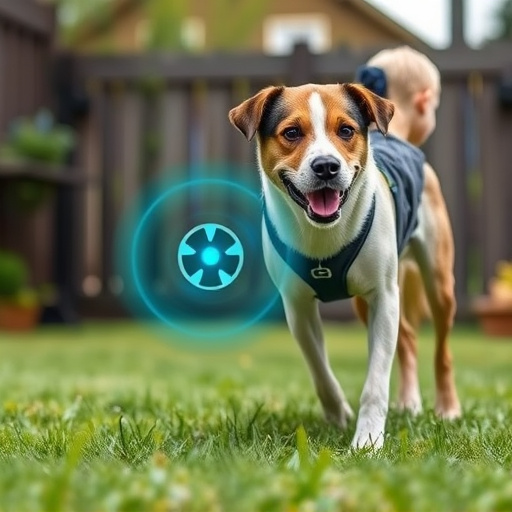Mounting options for electronic dog deterrents are crucial for effective and discreet implementation in various settings. Indoor models include wall/freestanding units for hallways and doorways, while outdoor options feature pole mounts and wall brackets. Customization allows pet owners to tailor the deterrent to breed, behavior, and environment. Training involves positive reinforcement and consistent sessions to teach pets to avoid shocks. Safe mounting and regular adjustments ensure both pet safety and successful training.
“Discover the revolutionary power of electronic pet deterrents, a modern solution for responsible pet ownership. These devices offer a humane and effective way to train your furry friends, preventing unwanted behaviors. In this comprehensive guide, we explore various mounting options tailored for both indoor and outdoor settings, ensuring flexibility and convenience. From understanding the technology to safety considerations, learn how to choose and implement the perfect Electronic Dog Deterrent, fostering a harmonious home environment with your pet.”
- Understanding Electronic Dog Deterrents
- Mounting Options: Indoor Solutions
- Outdoor Applications and Settings
- Training and Safety Considerations
Understanding Electronic Dog Deterrents
Electronic dog deterrents are innovative devices designed to train and manage canine behavior without resorting to traditional punishment methods. These tools emit specific sounds, vibrations, or mild electric shocks when a dog approaches or touches a certain area, encouraging them to learn and avoid unwanted actions. Understanding how these deterrents work is key to effective training. One of the versatile aspects of electronic dog deterrents lies in their mounting options for Electronic Dog Deterrent, allowing for customizable placement according to specific needs.
These options range from stake-based systems for outdoor use, ensuring a visible and discreet boundary, to wall-mounted or freestanding indoor units, perfect for training in confined spaces. Some advanced models even offer remote control features, enabling pet owners to adjust settings and monitor their dogs’ behavior from a distance. This flexibility ensures that the deterrent can be tailored to different environments, dog breeds, and behavioral issues, making it a versatile tool for responsible pet ownership.
Mounting Options: Indoor Solutions
When it comes to indoor spaces, mounting options for electronic pet deterrents play a crucial role in ensuring effective and subtle implementation. For homes or apartments, wall-mounted units are popular choices, offering a clean and discreet look while still providing strong signals to deter pets from off-limit areas. These devices can be strategically placed along common entry points, such as doorways or hallways, to discourage unwanted behavior without causing harm.
Additionally, some models offer the flexibility of multiple mounting options, including stand-alone designs that can be placed on tables or countertops for added versatility. This adaptability is particularly beneficial in smaller living spaces where wall space might be limited. By considering these indoor mounting solutions, pet owners can effectively manage their pets’ behavior while maintaining an aesthetically pleasing environment.
Outdoor Applications and Settings
Outdoor applications of electronic pet deterrents offer a versatile and effective solution for training and controlling pets in various settings. These devices can be mounted on fences, posts, or walls using different mounting options tailored to specific needs. For instance, flexible pole mounts allow for easy placement along walkways or garden borders, while sturdy wall brackets are ideal for securing the device to solid structures.
The settings for outdoor use often include adjustable sensitivity levels and customizable frequency ranges. This flexibility enables pet owners to adapt the deterrent to their environment, whether it’s a bustling backyard with multiple entry points or a quiet suburban lawn. By adjusting these settings, they can ensure effective training without causing discomfort to nearby humans or other animals.
Training and Safety Considerations
Training your pet to understand and respond appropriately to an electronic deterrent is a crucial step in its effective use. Positive reinforcement techniques, such as rewarding desired behaviors with treats or praise, can help teach pets to associate certain areas with comfort and safety, reducing their tendency to trigger the device. Consistency is key; regular training sessions using the specific settings and triggers you plan to employ can ensure your pet forms a strong association between staying in designated areas and avoiding unwanted shocks.
Safety considerations are paramount when introducing any electronic deterrent. Mounting options for devices, such as wall-mounted or wire-hidden fixtures, offer flexibility while ensuring they are out of reach of curious noses and paws. Always follow manufacturer guidelines regarding battery life and replacement to ensure the device remains reliable. Additionally, regularly inspect the device’s settings, adjusting them as your pet’s behavior changes or as new training milestones are achieved, to maintain a safe and effective environment for both you and your pet.
Electronic pet deterrents offer a safe and effective way to train and manage unwanted behaviors in both indoor and outdoor settings. By understanding different mounting options, such as those suitable for various floor types or outdoor elements, you can choose the ideal placement for your dog’s deterrent system. With careful training and safety considerations, these devices empower pet owners to teach their furry friends without resorting to traditional punishment methods. Implement these solutions, and you’ll be on your way to a happier, better-behaved companion.
